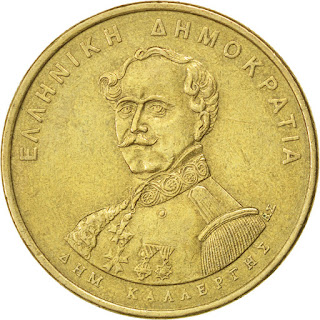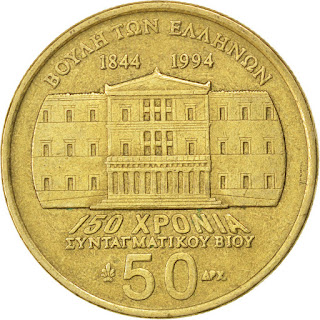Greek Coins 50 Drachmas 1994 Dimitrios Kallergis
Commemorative issue: 150th Anniversary of the Constitution Series - Dimitrios Kallergis
Obverse: Portrait of Dimitrios Kallergis in military uniform as a Major General.
Lettering: EΛΛHNIKH ΔHMOKPATIA BΣ ΔHM. KAΛΛEPΓHΣ.
Reverse: Center of Parliament Building.
Lettering: BOYΛH TΩN EΛΛHNΩN 1844 1994 150 XPONIA ΣYNTAΓMATIKOY BIOY 50 ΔΡΧ.
Edge: Milled.
Metal: Aluminium-Bronze.
Weight: 8.9 g.
Diameter: 27 mm.
Shape: Round.
Dimitrios Kallergis
Dimitrios Kallergis (born 1803, Crete, Ottoman Empire [now in Greece] — died Jan. 24, 1867, Athens, Greece) was a fighter of the Greek War of Independence, major general, politician and one of the most important protagonists of the 3rd September 1843 Revolution.
Kallergis was born in 1803 in Crete. Hailing from the distinguished Cretan Kallergis family, a historic family of Mylopotamos, the roots of which lay in the Byzantine Empire and which had risen to prominence under the Venetian domination of the island. He was left fatherless at an early age and he was sent to Russia to the care of the Tsar's Minister of Foreign Affairs, Count Nesselrode, who appears in some sources is mentioned as his uncle. After completing his general studies he went to Vienna in order to study medicine. On the outbreak of the Greek War of Independence went to the Morea and joined the insurgents.
Greek War of Independence
on 19 January 1822 he disembarked with his relatives, Emmanuel and Nikolaos Kallergis, and the officer Valianos in Hydra bringing with them ammunitions, whose worth was 100.000 rubles and a recommendation letter of bishop Ignatius Oungrovlachias.
During the summer of 1825 he took on along with his compatriot Emmanuel Antoniadis the leadership of the campaign in Crete. On 2 August, 200 revolutionaries occupied the Gramvousa’s fortress, in which many pirates assembled during the next months. The campaign failed while, according to the American Philhellene Samuel Gridley Howe, Kallergis was unsuitable for the leader’s position. Subsequently he participated in the Georgios Karaiskakis’ expedition in Roumeli and he was distinguished. In October 1826 he participated in the failed attack of Colonel Fabvier against Thebes (it was sent as reinforcement by Karaiskakis).
On January 30, 1827 he took part in the victorious battle of Kastella where he had significant contribution and on February 20 he defended strongly the area of the Three Towers, which was eventually conquered by the Ottomans but she had suffered several losses. He was captured by the enemy forces during the disastrous for the Greek troops battle of Phaleron, where he was leader of the Cretan fighters. Finally, he was released after paying a large sum of money from his family but during his captivity, his one ear was amputated.
After Independence
During the government of Ioannis Kapodistrias, Kallergis was one of his supporters. He served as his adjutant and he proceeded to the organization of a regular body of the cavalry, where he became deputy commander. After the governor’s assassination he had sided with Augustinos Kapodistrias and he actively participated in the civil conflicts of the time. During January 1832 he fought as a cavalry officer in the battles in Argos and in March in the battle of Loutraki where his and Nikitaras’ forces were defeated by the troops of Ioannis Kolettis.
At the same time, he followed a military career as an officer in the regular army while he was actively involved in the political issues of that period, first as a follower of the Russian party and then of the French party. In 1834, during the Bavarian regency and the Kolettis’ government he was imprisoned as a supporter of the Russian party, whose significant members had made at that time various uprisings in the Greek territory.
In 1843, as colonel of the cavalry, he was a leading figure of the 3 September 1843 Revolution against Otto which forced the king to dismiss his Bavarian ministers and grant a constitution. He was appointed military commandant of Athens, promoted to Major General and aide de camp to the king. In 1845 he was dismissed by the army and withdrew from Greece, occasioned by an incident between him and Queen Amalia. He went to London, where he became friend with Louis Napoleon, nephew of Napoleon I and later Emperor of the French, which he followed later in Paris and so he became follower of the French policy.
In 1848 he made an abortive descent on the Greek coast, in the hope of launching a revolution in the Greek kingdom. He was captured, but soon released and, after a stay in the island of Zante, went to Paris (1853). In 1854, during the Crimean War, he served as Minister of Military Affairs in the Alexandros Mavrokordatos cabinet — imposed by the British and French, and hence called “Ministry of Occupation” by the Greeks. Until Mavrokordatos’ arrival, Kallergis exercised authority as dictator, with the full support of the French occupation troops. This particular government recalled all the Greek officers who participated in the anti-Ottoman revolutionary movements in Thessaly, Epirus and Macedonia to return to Greece while by personal requirement of Kallergis, Otto's adjutants — Gennaios Kolokotronis, Spyromilios, Ioannis Mamouris and Gardikiotis Grivas — were dismissed, while while the hitherto Minister of Military Affairs, Skarlatos Soutsos, was suspended.
When he was minister, Kallergis formed for the first time in Greece a fire brigade. In September 1855, a serious episode of Kallergis with the royal couple entailed the fall of Mavrokordatos’ government.
In 1866 he participated in the two-day government of Dimitrios Voulgaris as Minister of Military Affairs. In mid-1866 he returned to Greece as chief equerry of King George I. He proposed to the king to assign him the Ministry of Foreign Affairs, arguing that with the help of the governments of France and Italy he would be able to accomplish the vision of the Megali Idea, but King George didn’t believe it. In the summer of the same year he was elected by the Cretans as leader of the Cretan Revolt, but in September he refused the post because of health problems.
In January 1867 he was appointed as Ambassador of Greece to the United States but during the trip he fell ill in Paris and returned to Athens, where he died on 8 April 1867 of hemiplegia.
Kallergis was depicted on the reverse of the Greek 50 drachmas commemorative coin issued in 1994 for the 150th anniversary of the first Greek Constitution.

